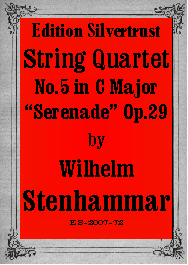Presents
Wilhelm Stenhammar
String Quartet No.5 in C Major, Op.29 "Serenade"
 Many
consider Stenhammar's six string quartets the most important set written between those of Brahms and Bartok. They represent a very important development
during the twenty five years he was writing chamber music. Tonally, they range
from middle late Romantic to late Sibelius. Outside of Sweden these fine works
are little known or played.
Many
consider Stenhammar's six string quartets the most important set written between those of Brahms and Bartok. They represent a very important development
during the twenty five years he was writing chamber music. Tonally, they range
from middle late Romantic to late Sibelius. Outside of Sweden these fine works
are little known or played.
Stenhammar (1871-1927) was trained as a pianist, became a virtuoso and was considered the finest Swedish pianist of his time. Unlike many virtuosi, Stenhammar was passionate about chamber music and spent nearly half of his life working closely with the Aulin Quartet, the top Swedish string quartet of its day and one of the best then performing in Europe. In fact, he toured throughout Europe with them for many years and a piano quintet was nearly always featured on their programs. Thus it is no accident that his quartets show a fine grasp of instrumental timbre and technique. The part writing is sure and evenly distributed with the instruments never being asked to perform in a non-violinistic manner.
The Fifth Quartet was begun in 1909. Quite possibly Stenhammar felt the need for something lighter after the powerful and searching Fourth Quartet. It was Stenhammar himself who gave this work the subtitle Serenade. He begins his serenade with a lively and playful Allegro molto con spirito. Though the music sounds nothing at all like Haydn, nonetheless, the spirit of Haydn and Viennese Classicism in the structural treatment of his themes. The second movement is unquestionably the most striking. Entitled Ballata, it is based on the Swedish folksong Riddaren Finn Komfusenfej. (The Knight Finn of Fusenfej goes a-courting). Stenhammar related how his uncle, who lived with the family, used to sing this song to the children. First comes the theme in which Fusenfej asks the King for his daughter's hand in marriage. Each succeeding variation paints a portrait of different personages, the Queen, the princess' brothers and sisters. It is a jolly tale which without warning turns into an elegy in which Fusenfej dies. It would be hard to find a more impressive set of variations. Next comes a short, very swift Scherzo, which literally explodes after the final soft notes of the Ballata die away. There are several surprises in this spectacular little gem. The finale, Allegro molto, is also quite fast and at times becomes a perpetuum mobile. It is full of high spirits and humor and brings the quartet to an end in a rousing fashion.
Again we have another masterpiece which if given by professional quartets will reap much praise from audiences. Certainly, it is well within the reach of experienced amateur players.
Parts: $24.95
Parts & Score: $31.95